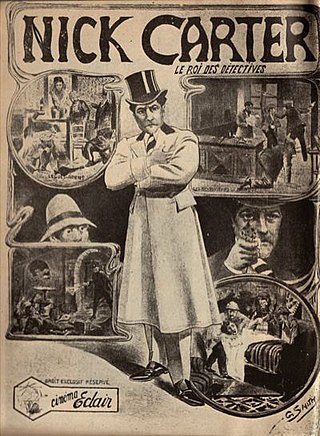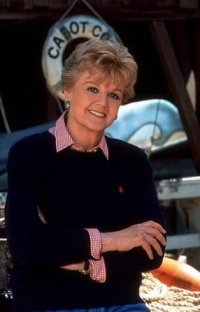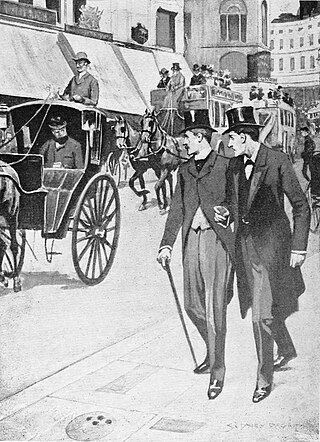Related Research Articles
Miss Jane Marple is a fictional character in Agatha Christie's crime novels and short stories. Miss Marple lives in the village of St. Mary Mead and acts as an amateur consulting detective. Often characterized as an elderly spinster, she is one of Christie's best-known characters and has been portrayed numerous times on screen. Her first appearance was in a short story published in The Royal Magazine in December 1927, "The Tuesday Night Club", which later became the first chapter of The Thirteen Problems (1932). Her first appearance in a full-length novel was in The Murder at the Vicarage in 1930, and her last appearance was in Sleeping Murder in 1976.

Detective fiction is a subgenre of crime fiction and mystery fiction in which an investigator or a detective—whether professional, amateur or retired—investigates a crime, often murder. The detective genre began around the same time as speculative fiction and other genre fiction in the mid-nineteenth century and has remained extremely popular, particularly in novels. Some of the most famous heroes of detective fiction include C. Auguste Dupin, Sherlock Holmes, and Hercule Poirot. Juvenile stories featuring The Hardy Boys, Nancy Drew, and The Boxcar Children have also remained in print for several decades.

A whodunit is a complex plot-driven variety of detective fiction in which the puzzle regarding who committed the crime is the main focus. The reader or viewer is provided with the clues to the case, from which the identity of the perpetrator may be deduced before the story provides the revelation itself at its climax. The investigation is usually conducted by an eccentric, amateur, or semi-professional detective.

Crime fiction, detective story, murder mystery, mystery novel, and police novel are terms used to describe narratives that centre on criminal acts and especially on the investigation, either by an amateur or a professional detective, of a crime, often a murder. It is usually distinguished from mainstream fiction and other genres such as historical fiction or science fiction, but the boundaries are indistinct. Crime fiction has several subgenres, including detective fiction, courtroom drama, hard-boiled fiction, and legal thrillers. Most crime drama focuses on crime investigation and does not feature the courtroom. Suspense and mystery are key elements that are nearly ubiquitous to the genre.
Simon Anthony Lee Brett OBE FRSL is a British author of detective fiction, a playwright, and a producer-writer for television and radio. As an author, he is best known for his mystery series featuring Charles Paris, Mrs Pargeter, Fethering, and Blotto & Twinks. His radio credits have included The Hitchhiker's Guide to the Galaxy, I'm Sorry I Haven't a Clue and Just a Minute.

Mystery is a fiction genre where the nature of an event, usually a murder or other crime, remains mysterious until the end of the story. Often within a closed circle of suspects, each suspect is usually provided with a credible motive and a reasonable opportunity for committing the crime. The central character is often a detective, who eventually solves the mystery by logical deduction from facts presented to the reader. Some mystery books are non-fiction. Mystery fiction can be detective stories in which the emphasis is on the puzzle or suspense element and its logical solution such as a whodunit. Mystery fiction can be contrasted with hardboiled detective stories, which focus on action and gritty realism.

Crime fiction is a typically 19th-, 20th- and 21st-century genre, dominated by British and American writers. This article explores its historical development as a genre.

A mystery film is a film that revolves around the solution of a problem or a crime. It focuses on the efforts of the detective, private investigator or amateur sleuth to solve the mysterious circumstances of an issue by means of clues, investigation, and clever deduction. Mystery films include, but are not limited to, films in the genre of detective fiction.

Jessica Beatrice "J. B." Fletcher is a fictional detective and writer and the main character and protagonist of the American television series Murder, She Wrote. Portrayed by award-winning actress Angela Lansbury, Fletcher is a best-selling author of mystery novels, an English teacher, amateur detective, criminology professor, and congresswoman. In 2004, Fletcher was listed in Bravo's "100 Greatest TV Characters". AOL named her one of the "100 Most Memorable Female TV Characters". The same website listed her among "TV's Smartest Detectives". She was ranked at number six on Sleuth Channel's poll of "America's Top Sleuths". Guinness World Records called her the "most prolific amateur sleuth".

Ellery Queen is an American TV drama series, developed by Richard Levinson and William Link, who based it on the fictional character of the same name. The series ran for a single season on NBC from September 11, 1975, to April 4, 1976. Jim Hutton stars as the eponymous sleuth, along with David Wayne as his father, Inspector Richard Queen.

The Murder at the Vicarage is a work of detective fiction by British writer Agatha Christie, first published in the UK by the Collins Crime Club in October 1930 and in the US by Dodd, Mead and Company later in the same year. The UK edition retailed at seven shillings and sixpence and the US edition at $2.00.

Nancy Drew: Girl Detective is a 2004–2012 book series which replaced the long-running Nancy Drew mystery series. This new series is written in first person narration, from Nancy's point of view, and features updated versions of the main Nancy Drew characters. New secondary characters are introduced to populate River Heights and appear over multiple books, adding a framework to Nancy's world.
Ed Lynskey is an American poet, critic, and novelist, mostly of crime fiction. He was born in 1956 in Washington, D.C. where he still lives and works. Lynskey received his B.A. (1979) and M.A. (1984) from George Mason University as well as did post-graduate study at The George Washington University. He writes five mystery series, including the P.I. Frank Johnson Mystery Series, the Isabel & Alma Trumbo Cozy Mystery Series, the Piper & Bill Robin Cozy Mystery Series, the Hope Jones Cozy Mystery Series, the Ginny Dove Cozy Mystery Series, and the Juno Patchen Cozy Mystery Series.

The gentleman detective, less commonly lady detective, is a type of fictional character. He has long been a staple of crime fiction, particularly in detective novels and short stories set in the United Kingdom in the Golden Age. The heroes of these adventures are typically both gentlemen by conduct and often also members of the British gentry. The literary heroes being in opposition to professional police force detectives from the working classes.

The Lodger is a novel by English author Marie Adelaide Belloc Lowndes. The short story was first published in the January, 1911 edition of McClure's Magazine, in 1911. Belloc Lowndes wrote a longer version of the story, which was published as a series in the Daily Telegraph in 1913 with the same name. Later that year, the novel was published in its entirety by Methuen Publishing.

A Beautiful Blue Death, by Charles Finch, is the first novel in a series of mysteries featuring Victorian gentleman and amateur detective Charles Lenox.
Girl detective is a genre of detective fiction featuring a young, often teen-aged, female protagonist who solves crimes as a hobby.
Sylvia Haymon was a British writer of mystery fiction, autobiography, and other fiction and nonfiction. As an adult, she worked in public relations, broadcasting, journalism, and farming, and published nonfiction that included two childhood memoirs, a historical novel, biographies of Bonnie Prince Charlie and Monmouth, and a history of Norwich, her birthplace. Writing under the pseudonym S. T. Haymon, she became well-known for her police procedural series featuring Detective Inspector Ben Jurnet. She won the Crime Writers Association Silver Dagger Award in 1983 for Ritual Murder.
References
- ↑ What Makes a Cozy Mystery?|Novel Suspects
- ↑ 25 Of The Absolute Best Cozy Mystery Series|Book Riot
- 1 2 3 What Makes a Cozy Just That?|Cozy Mystery List
- ↑ Stasio, Marilyn (October 18, 1992). "CRIME/MYSTERY; Murder Least Foul: The Cozy, Soft-Boiled Mystery". The New York Times.
- ↑ Christian, Citron (11 April 2014). "Was Angela Lansbury Serial Killer on Murder She Wrote? | TheBlot". TheBlot Magazine. Retrieved 14 October 2019.
- ↑ Theme page on cozy mystery blog
- ↑ Novel Investigation: A Brief History of Cozy Mysteries|Novel Suspects
- 1 2 3 4 "Rita Mae Brown". Cozy-Mystery.com.
- ↑ 25 Of The Absolute Best Cozy Mystery Series|Book Riot
- ↑ Coronavirus: Murder, but gentler: 'Cozy' mysteries a pandemic-era balm|CTV News
- ↑ Snyder, Diane (2 February 2022). "'Sister Boniface': Crime-Solving Nun Gets the Spotlight in 'Father Brown' Spinoff". TV Insider.
- ↑ Saunders, Tristram Fane (21 June 2023). "Thank heavens Bill Nighy isn't too grand to grace our airwaves". The Telegraph.